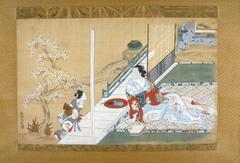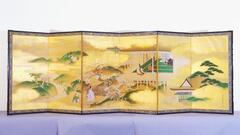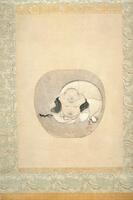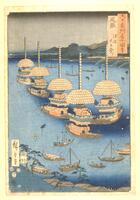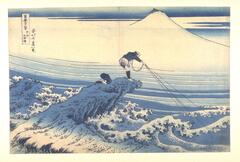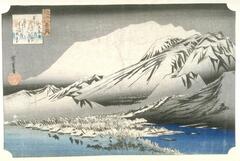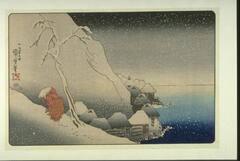17 Items in this Learning Collection
Collection Object
Collection Object
Collection Object
Collection Object
Collection Object
Collection Object
Collection Object
Collection Object
Collection Object
Collection Object
Collection Object
Collection Object
Collection Object
Collection Object
Collection Object
Copyright
All Rights Reserved
()
Genji espies Murasaki for the first time, from the Wakamurasaki chapter of The Tale of Genji
Accession Number
2002/1.168
Title
Genji espies Murasaki for the first time, from the Wakamurasaki chapter of The Tale of Genji
Artist(s)
Kanō Tsunenobu
Object Creation Date
circa 1670-1680
Medium & Support
ink, color, and gold pigment and foil on paper
Dimensions
45 1/16 in x 136 1/4 in (114.46 cm x 346.08 cm)
Credit Line
Museum Purchase made possible by the Friends of the Museum of Art
Label copy
In the seventeenth century, large-scale folding screens
with Genji themes were popular items in the wedding
trousseaus of members of the military aristocracy. Such
screens were decorated with scenes idealizing courtly love,
rather than the darker moments in the novel. This episode
relates Genji’s discovery of the villa of a noblewoman nun
with temporary charge of her granddaughter, Murasaki
(Wakamurasaki means “the young Murasaki”). Genji peeks
through the fence, drawn by the commotion caused when
a maid accidentally releases Murasaki’s pet sparrow. He
is struck by the beauty of Murasaki, who later becomes
his favorite concubine. In this rendering of their fateful
first encounter, a cherry tree in full bloom suggests the
blossoming of romance, while the distant stream and
hilltops indicate the isolated setting.
The style of these paintings looks back to the earliest
Genji pictures of the eleventh and twelfth centuries,
which established a classical model for the theme: gold
and bright mineral pigments are thickly applied to create
a rich, jewel-like surface, and figures are drawn with
generic features to allow viewers to imaginatively project
themselves into the scene.
Fall 2015 Gallery Rotation
------------
On an excursion in the mountains, Genji discovers the villa of a tonsured noblewoman. The nun has temporary charge of her granddaughter, Murasaki. (Wakamurasaki means “the young Murasaki.”) Drawn by the commotion caused when a maid accidentally released Murasaki’s pet sparrow, Genji peeks through the fence. Struck by Murasaki’s beauty, he arranges to adopt her; she later became his favorite concubine. In this rendering of their fateful first encounter, a cherry tree in full bloom suggests the blossoming of romance, while a more distant stream and hilltops indicate the isolated setting.
In the seventeenth century, large-scale folding screens of Genji themes became popular trousseau items among members of the military aristocracy. For these auspicious purposes, artists chose scenes that idealized courtly love, rather than the darker moments in the novel. The style of these paintings looks back to the earliest Genji pictures of the eleventh and twelfth centuries, which had established a classical model for the theme: gold and bright mineral pigments are thickly applied to create a rich, jewel-like surface, and figures are drawn with stylized features to allow viewers to imaginatively project themselves into the scene.
Maribeth Graybill, Senior Curator of Asian Art
Exhibited in "Stories from the Past: Narrative in Asian Art "
January 24–July 25, 2004
Subject matter
On an excursion in the mountains, Genji discovers the villa of a tonsured noblewoman. The nun has temporary charge of her granddaughter, Murasaki. (Wakamurasaki means “the young Murasaki.”) Drawn by the commotion caused when a maid accidentally released Murasaki’s pet sparrow, Genji peeks through the fence. Struck by Murasaki’s beauty, he arranges to adopt her; she later became his favorite concubine. The cherry tree in full bloom suggests the blossoming of romance.
In the seventeenth century, large-scale folding screens of Genji themes became popular trousseau items among members of the military aristocracy. For these auspicious purposes, artists chose scenes that idealized courtly love, rather than the darker moments in the novel. The style of these paintings looks back to the earliest Genji pictures of the eleventh and twelfth centuries, which had established a classical model for the theme: gold and bright mineral pigments are thickly applied to create a rich, jewel-like surface, and figures are drawn with stylized features to allow viewers to imaginatively project themselves into the scene.
Physical Description
Among a gold and bright mineral pigmented landscape, Genji stands below a cherry tree in full bloom and watches Murasaki, who stands in an architectural structure. A distant stream and hilltops indicate the isolated setting.
Primary Object Classification
Painting
Primary Object Type
screen
Collection Area
Asian
Rights
If you are interested in using an image for a publication, please visit http://umma.umich.edu/request-image for more information and to fill out the online Image Rights and Reproductions Request Form.
Keywords
Allegory and Literature
Figures
Landscapes
allegory (artistic device)
buildings
flowers
gold
gold (metal)
hills
house
landscapes (environments)
literature (writings)
lovers
streams
trees
2002/1.168
Title
Genji espies Murasaki for the first time, from the Wakamurasaki chapter of The Tale of Genji
Artist(s)
Kanō Tsunenobu
Object Creation Date
circa 1670-1680
Medium & Support
ink, color, and gold pigment and foil on paper
Dimensions
45 1/16 in x 136 1/4 in (114.46 cm x 346.08 cm)
Credit Line
Museum Purchase made possible by the Friends of the Museum of Art
Label copy
In the seventeenth century, large-scale folding screens
with Genji themes were popular items in the wedding
trousseaus of members of the military aristocracy. Such
screens were decorated with scenes idealizing courtly love,
rather than the darker moments in the novel. This episode
relates Genji’s discovery of the villa of a noblewoman nun
with temporary charge of her granddaughter, Murasaki
(Wakamurasaki means “the young Murasaki”). Genji peeks
through the fence, drawn by the commotion caused when
a maid accidentally releases Murasaki’s pet sparrow. He
is struck by the beauty of Murasaki, who later becomes
his favorite concubine. In this rendering of their fateful
first encounter, a cherry tree in full bloom suggests the
blossoming of romance, while the distant stream and
hilltops indicate the isolated setting.
The style of these paintings looks back to the earliest
Genji pictures of the eleventh and twelfth centuries,
which established a classical model for the theme: gold
and bright mineral pigments are thickly applied to create
a rich, jewel-like surface, and figures are drawn with
generic features to allow viewers to imaginatively project
themselves into the scene.
Fall 2015 Gallery Rotation
------------
On an excursion in the mountains, Genji discovers the villa of a tonsured noblewoman. The nun has temporary charge of her granddaughter, Murasaki. (Wakamurasaki means “the young Murasaki.”) Drawn by the commotion caused when a maid accidentally released Murasaki’s pet sparrow, Genji peeks through the fence. Struck by Murasaki’s beauty, he arranges to adopt her; she later became his favorite concubine. In this rendering of their fateful first encounter, a cherry tree in full bloom suggests the blossoming of romance, while a more distant stream and hilltops indicate the isolated setting.
In the seventeenth century, large-scale folding screens of Genji themes became popular trousseau items among members of the military aristocracy. For these auspicious purposes, artists chose scenes that idealized courtly love, rather than the darker moments in the novel. The style of these paintings looks back to the earliest Genji pictures of the eleventh and twelfth centuries, which had established a classical model for the theme: gold and bright mineral pigments are thickly applied to create a rich, jewel-like surface, and figures are drawn with stylized features to allow viewers to imaginatively project themselves into the scene.
Maribeth Graybill, Senior Curator of Asian Art
Exhibited in "Stories from the Past: Narrative in Asian Art "
January 24–July 25, 2004
Subject matter
On an excursion in the mountains, Genji discovers the villa of a tonsured noblewoman. The nun has temporary charge of her granddaughter, Murasaki. (Wakamurasaki means “the young Murasaki.”) Drawn by the commotion caused when a maid accidentally released Murasaki’s pet sparrow, Genji peeks through the fence. Struck by Murasaki’s beauty, he arranges to adopt her; she later became his favorite concubine. The cherry tree in full bloom suggests the blossoming of romance.
In the seventeenth century, large-scale folding screens of Genji themes became popular trousseau items among members of the military aristocracy. For these auspicious purposes, artists chose scenes that idealized courtly love, rather than the darker moments in the novel. The style of these paintings looks back to the earliest Genji pictures of the eleventh and twelfth centuries, which had established a classical model for the theme: gold and bright mineral pigments are thickly applied to create a rich, jewel-like surface, and figures are drawn with stylized features to allow viewers to imaginatively project themselves into the scene.
Physical Description
Among a gold and bright mineral pigmented landscape, Genji stands below a cherry tree in full bloom and watches Murasaki, who stands in an architectural structure. A distant stream and hilltops indicate the isolated setting.
Primary Object Classification
Painting
Primary Object Type
screen
Collection Area
Asian
Rights
If you are interested in using an image for a publication, please visit http://umma.umich.edu/request-image for more information and to fill out the online Image Rights and Reproductions Request Form.
Keywords
Allegory and Literature
Figures
Landscapes
allegory (artistic device)
buildings
flowers
gold
gold (metal)
hills
house
landscapes (environments)
literature (writings)
lovers
streams
trees


